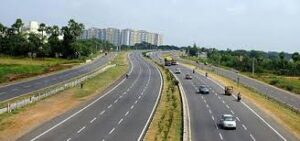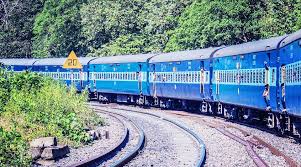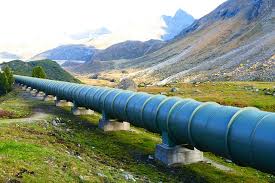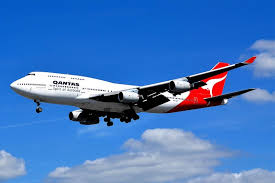UNDERSTANDING WHY ARE THESE CALLED AS THE LIFELINES OF NATIONAL ECONOMY

CARGO SHIP, LIFELINES OF NATIONAL ECONOMY
Read the best explanation and prepare notes from –Lifelines of National Economy. If we take an Ariel view of our country we will see many lines just like the lines in our hands. What exactly are these lines? These lines are nothing but the roads, railway tracks which connects one place with the other. So in this Geography chapter lifelines of national economy, students are mainly going to know about the different modes of transportation and the importance of communication. After reading this chapter children will also understand why these means of transportation and communication are known as Lifelines of national economy. CLASS X MANUFACTURING INDUSTRIES Here we present all important NCERT solutions with some expected and important questions from board point of view. NTSE – CLASS X – GEOGRAPHY These solved questions and answers will definitely help the students in understanding the Lifelines of national economy.
GEOGRAPHY: CLASS X CHAPTER 7 – LIFELINES OF NATIONAL ECONOMY
INTRODUCTION: LIFELINES OF NATIONAL ECONOMY
There are many lines in our hands (palm).
Study of these lines are called Palmistry.
People predict your future by seeing these lines.
These lines indicate about your health, wealth, education, marriage, children etc.
God knows whether these predictions are right or wrong.
But, even if these predictions are correct, you will agree with me that the most important line is the Lifeline.
All other lines depend upon the Lifeline.
Similarly, if we take an Ariel view of our country we will see many lines just like the lines in our hands.
What exactly are these lines?
These lines are nothing but the roads, railway tracks which connects one place with the other.
Good and fast connectivity saves time and ensures development and prosperity of the country.
Therefore, we can say that fast means of transport (Road, Rail, Air & Water) and communication are the “LIFELINES OF NATIONAL ECONOMY.”
For all types of Questions and Answers from CLASS X MANUFACTURING INDUSTRIES click the given link.
ROADWAYS: LIFELINES OF NATIONAL ECONOMY
There is free flow of blood in our arteries and veins and it keeps us healthy.
Similarly, there should be free flow of vehicles on the roads to keep the country’s economy healthy.
India has more than 2.3 million km. of roads including kuccha and pucca both.
Roads are considered important than the rails.
Do you know why?
HOW ROAD TRANSPORT IS MORE IMPORTANT THAN RAIL TRANSPORT?
- Construction cost of road is lower than that of railway tracks.
- Roads can be constructed in any type of topography (plains, plateaus, mountains etc.)
- It can be constructed at 45* angle (either vertical or slope)
- It can turn at 90 degree angle or can even take a “U” turn but railways cannot.
- Road transport is economical and easily available for short distances.
- It can reach up to your door e.g. auto, truck, car or tractor can reach up to the door.
- Therefore, loading and unloading of goods become very easy.
- Road acts as a connecter. It connects airport, railway station and sea ports.
SIX TYPE OF ROADS IN INDIA
In India roads are classified in the following six classes according to their capacity.
1. GOLDEN QUADRILATERAL SUPER HIGHWAYS / EXPRESSWAYS

GOLDEN QUADRILATERAL SIX LANE ROADS IN INDIA
i) a major project by Atal Bihari government to link all the four major cities Delhi, Mumbai, Chennai and Kolkata.
ii) to connect the Northernmost (Srinagar) with the southernmost part (Kanyakumari) which will be known as North-South corridor and
iii) to connect the Easternmost (Silchar) with the Westernmost part (Porbandar) which will be known as East-West corridor.
iv) These roads will have six lanes.
v) The major objective of these roads are to reduce time and distance between the mega-cities.
vi) This project is under NHAI (NATIONAL HIGHWAY AUTHORITY of INDIA).
2. NATIONAL HIGHWAYS
i) These roads connect all the state capital with the National capital.
ii) In this way all extreme ends of the country is connected.
iii) Central Public Works Department (CPWD) looks after these roads.
iv) However, land is provided by the State government but construction is done by the central government.
v) NH 7 which connects Varanasi to Kanyakumari is the longest National Highway .
3. STATE HIGHWAYS
i) State Public Works Department (SPWD) is responsible for constructing and maintenance of these roads.
ii) These roads connect all the district headquarters with the state capital.
4. DISTRICT ROADS
i) To connect two or more tehsils and important towns in the district with the district headquarters.
ii) Zila Parishad maintains these roads.
iii) Moreover, सड़कें भी मेक-अप करती हैं District roads are within a particular district only.
5. OTHER ROADS
i) Pradhan mantri grameen sadak yojna is an example of other road.
ii) Government wants all villages to be connected with the nearest pucca road.
iii) The length of road varies from 1 km to 5 kms.
6. BORDER ROADS
i) You will find these roads at the borders of your country.
ii) Border Road Organization (BRO) constructs and maintains these roads.
iii) These roads are important from the safety point of view.
iv) These roads not only provide safety to the country but also help in the development of remote areas.
LEARN HOW TO MAKE THE MAP OF INDIA USING DOUGH https://www.youtube.com/watch?v=IWslVIr9ZsI EASILY AT HOME FOR ACTIVITY OR SCHOOL EXHIBITION.
DEMERITS OF ROADWAYS:
i) For long distances, roadways are costly, unsafe and uncomfortable.
ii) Basic facilities like waiting hall, food, Doctor, Ambulance, Toilets etc are missing.
iii) Can carry only a limited number of passengers and goods.
iv) Due to poor roads, सड़कें भी मेक-अप करती हैं it is time consuming.
v) No or less street lights increases the possibility of accidents.
RAILWAYS: LIFELINES OF NATIONAL ECONOMY

INDIAN RAILWAYS
i) It is the largest public sector undertaking in the country.
ii) First train started in 1853 from Mumbai to Thane.
iii) Railways help in business, tourism, sightseeing and transportation of goods.
iv) It not only binds the country but also accelerate the development of Industries and AGRICULTURE – II .
v) Due to different type of landforms, it is difficult to construct railway tracks specially in hilly हिमालय-भारत का सबसे कमज़ोर पर्वत and marshy areas.
HOW ARE RAILWAYS BETTER THAN ROADWAYS?
i) For long distances, railways are cheap, safe and comfortable.
ii) Basic facilities like food, STD booth, Ambulance, Doctors, water, food and toilets are available.
iii) Can carry many passengers and goods from one place to another.
DEMERITS OF RAILWAYS:
i) Late running and overcrowded trains.
ii) Few people travel without tickets.
iii) Not available all the time and cannot reach up to our door steps.
PIPELINES: LIFELINES OF NATIONAL ECONOMY

PIPELINES: NEW MODE OF TRANSPORT
Can you see the electrical wiring in your house from switch board to fan, or your cable wiring?
No because the wiring are done through pipelines.
Similarly, you must have seen underground water Pipelines.
Pipelines are comparatively new mode of transport.
Today these are used to transport petrol, Natural Gas, crude oil etc.
ADVANTAGES OF PIPELINE TRANSPORTATION
i) It does not occupy space as it is laid underground.
ii) Easy to transport petrol, water, Natural gas and even solids in the form of slurry.
iii) No trans-shipment losses i.e. no problem of loading and unloading.
iv) Initial cost is high but running cost is low.
v) can be laid down in any type of land like hills, plateaus, deserts etc.
vi) Less chances of theft.
**** Elon Musk’s Hyperloop would be a transport revolution. Speed more than 1000 kms/hr. https://www.youtube.com/watch?v=gsvxHJWnP_s Click here to know more.
DISADVANTAGES OF PIPELINE TRANSPORTATION
i) Initial cost of laying pipelines is high.
ii) Leakage in pipe can lead to wastage of Resources .
iii) Difficult to maintain as detection of leakage is difficult.
WATERWAYS: LIFELINES OF NATIONAL ECONOMY
Do you know that like National Highways there are National Waterways National Waterways also?
Waterways are mainly of two types:
i) INLAND WATERWAYS – If you have to travel within the country it is called inland waterways.
It comprises of lakes, canals, Rivers, Lagoons etc.
ii) SEA ROUTES: Sea routes connect one country with another country.
It helps in transporting goods (export-import) internationally.
ADVANTAGES OF WATERWAYS:
i) Firstly, it is the cheapest mode of transport.
ii) Secondly, heavy and bulky goods can easily be transported.
iii) Maintenance cost is very low.
iv) However, they are useful during Natural disasters like flood, earthquake etc.
v) Useful for foreign trade.
DISADVANTAGES OF WATERWAYS:
i) It is the slowest and cheapest mode of transport.
ii) But, not available everywhere.
iii) Only perennial rivers can be used.
iv) Not good for perishable items.
v) Moreover, it is highly risky.
IMPORTANT NATIONAL WATERWAYS IN INDIA:
i) N..W. No. 1 – From Allahabad (U.P) to Haldia (W.B) through river Ganga. (1620 km)
ii) N..W. No. 2 – From Sadia (Assam) to Dhubri (Assam) through Brahmaputra river.(891 km)
iii) N..W. No. 3 – In the west coast canal in Kerala (205 km)
iv) N..W. No. 3 – From Kankinada to Pudducherry canal system connecting river Godavari and Krishna. (1078 km)
MAJOR SEA PORTS
India has a vast coastline of 7516 km.
95% of our export takes place through the coast.
India has 12 major and many minor sea ports.
Although there are many sea ports in India but here we will take up only those which are important from exam point of view.
PORTS ON WESTERN COASTS OF INDIA:
Easy way to remember is that there is one major port in every state Gujarat, Maharashtra, Goa, Karnataka and Kerala.
KANDLA SEA PORT (GUJARAT) VERY IMPORTANT
i) It was the first port to develop after Independence.
ii) After partition Karachi port went to Pakistan.
iii) Load on Mumbai port increased.
iv) Therefore, to share and reduce the load of Mumbai, Kandla port was developed in Gujarat.
v) It is a tidal port.
MUMBAI SEA PORT (MAHARASHTRA):
i) Located on the west coast of India.
ii) It is the biggest port.
iii) This port is spacious and Natural with well sheltered harbour.
iv) New Jawahar Lal port has been developed to reduce the burden of Mumbai port.
MARMAGAO PORT (GOA):
i) Major iron ore exporting port of India.
ii) 50% iron ore is exported from here.
NEW MANGALORE SEA-PORT (KARNATAKA):
i) Located in Karnataka.
ii) Useful in the export of Iron ore coming from Kudremukh (Largest iron ore mines in the world).
KOCCHI SEA PORT (KERALA):
i) Southernmost port of the west coast.
ii) Natural port with entrance through lagoon.
MAJOR PORTS ON EASTERN COASTS OF INDIA:
One major port in every state. Only Tamilnadu has two major ports – Chennai and Tuticorin.
HALDIA SEA PORT (W.B):
i) Haldia port is located in West Bengal.
ii) Constructed to reduce the load of Kolkata port. (Pl. remember Kolkata is not a sea port, it is a riverine port)
PARADWEEP PORT (ORISSA):
i) Located in Orissa.
ii) Used for exporting Iron ore.
VISHAKHAPATNAM SEA PORT ( A.P)
i) Located in Andhra Pradesh.
ii) Used for exporting Iron ore.
iii) It is the deepest, Land locked and well protected port.
CHENNAI SEA PORT(TAMILNADU);
i) One of the oldest artificial sea ports in India.
ii) Busiest sea port after Mumbai.
TUTICORIN SEA PORT ( TAMILNADU):
i) SOUTHERNMOST PORT IN INDIA.
II) It has a natural harbor.
AIRWAYS: MAJOR KEY POINTS TO REMEMBER

AIRWAYS
i) Fastest mode of transport.
ii) Nationalized in 1953
iii) Indian airlines is a domestic airways, Flies within the country.
iv) Air India provides international services.
v) There are private airlines also providing domestic and International flights.
ADVANTAGES OF AIRWAYS:
i) Fastest mode of transport.
ii) comfortable and saves time.
iii) Useful during natural calamities and Medical emergencies.
iv) Can easily cross mountains, rivers, seas oceans, forests etc.
v) Also important from defense point of view.
DISADVANTAGES OF AIRWAYS:
i) very costly. Common people cannot afford.
ii) Not available everywhere and every time.
iii) Highly risky.
COMMUNICATION: LIFELINES OF NATIONAL ECONOMY
There many types of communication such as silent, personal, verbal, written and mass communication.
i) PERSONAL COMMUNICATION:
It includes talking to someone or expressing your feelings in front of someone. It is a two way communication.
ii) WRITTEN COMMUNICATION:
Expressing through writing is called written communication. It includes letters, books, articles etc. Indian Postal network is the largest in the world.
iii) MASS COMMUNICATION:
When we communicate with large number of people through a media, it is called mass communication.
It is also a one way communication.
Foe example, on a T.V. the news reader says India has won the world cup.
This news reaches to a large number of people at a time.
Therefore, T.V., Radio, Newspaper, Cinema, BOLLYWOOD QUIZ: INDIAN HERITAGE Internet etc are the examples of Mass communication.
Moreover, India is the second largest producer of feature films HERITAGE QUIZ – INDIAN CINEMA in the world.
INTERNATIONAL TRADE: LIFELINES OF NATIONAL ECONOMY
Trade simply means exchange of goods.
The place where exchange takes place is called market.
Local trade takes place locally within town, cities or villages.
State level trade takes place within states and
Trade between two countries are called International trade.
Increase in International trade of a country is an index to it’s economic prosperity.
When the value of export is more than the value of import it is favorable balance of trade.
Similarly, चाइना से क्या सीखें ? When the value of import is more than the value of export it is Unfavorable balance of trade.
Therefore, the difference between the value of export and import is Balance of trade.
TOURISM AS A TRADE: LIFELINES OF NATIONAL ECONOMY
When People stay away from home for business, recreation or for any other purpose, is known as tourism.
People from other countries arriving India has increased.
Thereby increasing the income of the country through tourism.
Tourism also promotes unity and provide support to local handicrafts.
Helps in the development of International understanding and promotes Indian culture and HERITAGE .
People from foreign countries visit India अंडमान और निकोबार द्वीप समूह for it’s rich heritage, culture, medical, business etc.
FREQUENTLY ASKED QUESTIONS IN CLASS X FROM LIFELINES OF NATIONAL ECONOMY
MULTIPLE CHOICE QUESTIONS: 1 MARK
Q1. Countries like Nepal and Bhutan are called_______?
A. Coastal countries
B. Island countries
C. Land locked countries
D. Gulf countries
Q2. The Highway projects are being implemented by_________?
A. State public works department
B. Central public works department
C. National highway authority of India
D. Border road organization
Q3. Which two of the following extreme locations are connected by the East-West Corridors.
A. GUWAHATI TO AHMEDABAD
B. SILCHAR TO PORBANDAR
C. SILCHAR TO SURAT
D. GUWAHATI TO PORBANDAR
4. Air transport was Nationalized in the year
A. 1953
B. 1963
C. 1960
D.1973
5. The first port developed soon after independence is________?
A. Chennai
B. Kandla
C. Vishakhapatnam
D. Haldia
6. Which two places are connected by NH 7?
A. Delhi and Amritsar.
B. Kolkata and Mumbai
C. Varanasi and Kanyakumari
D. Silchar and Porbandar.
7. Which river is related to National Waterways No. 1?
A. Ganga
B. Godavari
C. Krishna
D. Brahmaputra.
8. Which one of the following is a riverine port of India?
A. Vishakhapatnam
B. Paradweep
C. Kolkata
D. Kochi
9. Which one of the following is not an example of Mass communication?
A. Internet
B. Newspaper
C. Letters
D. Cinema
10. Which is the deepest land locked port of India?
A. Chennai
B. Vishakhapatnam
C. Haldia
D. New Mangalore
ANSWER THE FOLLOWING QUESTIONS IN NOT MORE THAN 20 WORDS.
Q1. What does “Road density” mean?
Ans) The length of road per 100 Sq.km of area is known as road density.
Q2. What is the main objective of super Highways?
Ans) Main objective of super Highways is to reduce time and distance between four mega cities.
Q3. Why is an efficient means of transport considered as a pre-requisite for fast development?
Ans) The pace of development of a country depends upon two factore:
a) the production of goods and services and
b) their movement over space.
Q4. Mention any two advantages of pipeline transportation.
i) Easy to transport petrol, water, Natural gas and even solids in the form of slurry.
iii) No trans-shipment losses i.e. no problem of loading and unloading.
Q5. What is the importance of Indian railways?
Ans) Importance of Indian railways are:
i) it is the principle mode of transportation for goods and passengers both.
ii) Railways make it possible to conduct number of activities such as sightseeing, business, recreation along with transportation of goods.
Q6. In which way “Mass Communication” is useful to us?
Ans) Mass communication creates awareness among people about various National programs and policies along with providing entertainment.
Q7. What do you mean by “Balance of Trade”?
Ans) The “Balance of Trade” of a country is the difference between its exports and imports. (Export – import = Balance of trade.)
SHORT ANSWER TYPE QUESTIONS: 3 MARKS
Q1. “The advancement of International trade of a country is an index of its economic development.” Justify the statement. (CBSE)
Ans) “The advancement of International trade of a country is an index of its economic development” because:
i) International trade helps in exchange of surplus goods.
ii) No country in the world today can survive without international trade.
iii) Favorable balance of trade brings foreign exchange and shows economic development of a country.
Q2. Why is air travel economical in North-Eastern India?
Ans) Air travel is economical in North-Eastern India because:
i) Airways can easily cross high mountains, forests, deserts, sea and oceans.
ii) North-Eastern regions of India have big rivers, dense forests, uneven land makes the construction of roads and rails difficult.
iii) Therefore, air travel makes it easier in connecting the places in this region.
Q3. Why do the movement of goods and services from one place to another require fast and efficient means of transport? (CBSE)
Ans) Movement of goods and services from one place to another require fast and efficient means of transport because:
i) Goods and services cannot move from supply areas to demand areas on their own. e.g. agricultural products reach industries with the help of transportation.
ii) Heavy and bulky goods can not reach other countries without transport facility. e.g. Oil comes to India by ships from the Gulf countries.
iii) For fast and quick delivery of products we also need fast means of transportation. e.g. raw materials reaching to the industries from mines.
Q4. “Roadways still have an edge over Railways”. Support the statement with arguments. (CBSE)
Ans) Yes there is no doubt that roadways have an edge over railways because:
i) Construction cost of roadways is much lower than that of railways.
ii) Roadways can be constructed in any type of land but railways cannot.
iii) Roadways connects every village and town in the remotest location but railways can not.
iv) For short distances roads are more convenient and comfortable than railways.
v) Moreover, Railways, Airways and Waterways are connected by roadways.
Q5. Mention any three disadvantages of waterways?
Ans) Three disadvantages of waterways are:
i) It is the slowest mode of transport.
ii) Failure in monsoon results in less water in rivers.
iii) Highly risky and not available everywhere.
Q6. Mention the importance of Kandla sea port.
Ans) i) Kandla sea port was developed just after the Independence.
ii) It was developed to reduce the load of Mumbai sea port.
iii) It handles exports and imports of industrial and agricultural products mainly from North India.
Q7. Why is Tourism known as a trade? (CBSE)
Ans) Tourism is considered as trade because:
i) More than 15 million people are directly engaged in this industry.
ii) It supplements the income of local handicrafts.
iii) Helps in the growth of National income by bringing foreign exchange.
HOW TO PREPARE AND ATTEMPT LONG ANSWER TYPE QUESTIONS: 5 MARKS
In long answer type questions, do not really write long answers. Now a days the examiner just looks for five valid points related to the question. But, one thing is important to note that if the points are in one or two words, it needs explanation. If the points are long enough say one sentence, it does not require any explanation.
Q1. WHY ARE MEANS OF TRANSPORTATION AND COMMUNICATION CALLED THE LIFELINE OF A NATIONAND ITS ECONOMY? (NCERT)
Ans) Means of transportation and communication are called the Lifeline of a nation because of following reasons:
- They provide a link to transfer and exchange of goods quickly.
- Helps in distribution of finished products.
- Covers a larger area within the country and the world.
- When the product reaches to a larger number of consumers with the help of fast means of transportation and communication, it increases growth in trade.
- Increasing growth in trade increases the income of the country or boosts the economy of the nation.
Hence, it can be concluded that “Means of transportation and communication are rightly called the Lifeline of a nation”.
Q2. WRITE A NOTE ON THE CHANGING NATURE OF THE INTERNATIONAL TRADE IN THE LAST FIFTEEN YEARS. (NCERT)
Ans) Changing nature of the International trade in the last fifteen years:
- Domestic and International trade has increased in the last fifteen years.
- India has increased the export of agricultural and mining products, jewelry and chemicals in the past decades.
- Growth in trade and services and human resources has also increased in the global market.
- Due to globalization, the whole world has become a big market.
- Exchange of commodities and goods have been superseded by the exchange of information and knowledge in the past fifteen years.
Q3. Explain with examples the conditions responsible for uneven distribution pattern of the railway network in India. (HOTS- CBSE QUESTION)
Ans) Physical and economic factors have influenced the distribution pattern of the Indian Railways network:
- Railway network in the Northern plains:
a) Plain and level land, dense population and rich agricultural resources provided dense network of railways.
b) However, large and perennial rivers and construction of railway bridges over their wide banks was a difficult task.
2. Railway network in the Himalayan region:
a) construction of railway tracks can be done on lower hills or in the gaps by making tunnels.
b) cost of construction is high.
c) Due to uneven land surface, less population and lack of economic opportunities, these regions are unfavorable for railways.
3. Railway network in the Plateau regions:
a) Plateau regions are rich in mineral resources.
b) vast availability of resources, industries and employment opportunities encourage the development of railways.
c) However, it is not that easy to construct railway tracks in the hard and uneven plateau regions.
4. Railway network in the desert region:
There is less network of railways in the sandy desert due to sand dunes and sinking or railway tracks under the sand.
5. Railway network in the Swamps and forested areas of India:
Swamps of Gujarat and Bengal, dense forested area of Madhya Pradesh, Chhattisgarh, Jharkhand and North-East India are also not suitable for the development of railways.
CONCLUSION:
We hope these notes as well as questions and answers from “Lifelines of National Economy” helped you in your studies. Keep learning and stay tuned. keep visiting the website for NTSE, Green Olympiad, Heritage Quiz, CBSE Board and other competitive exams.




0 Comments